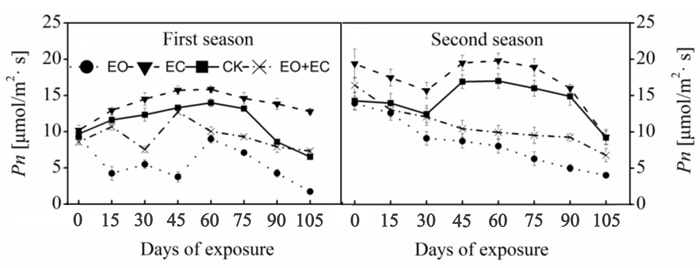| Tweet | Follow @co2science |
Paper Reviewed
Wang, L.L., Li, Y.Y., Li, X.M., Ma, L.J. and He, X.Y. 2019. Co-ordination of photosynthesis and stomatal responses of Mongolian oak (Quercus mongolica Fisch. Ex Ledeb.) to elevated O3 and/or CO2 levels. Applied Ecology and Environmental Research 17: 4257-4268.
Tropospheric ozone (O3) is a harmful air pollutant that damages plants. Its concentration is projected to rise by 20% or more in the next three decades in many industrialized regions, increasing even higher by the end of the century. In contrast, rising concentrations of atmospheric CO2 are expected to enhance plant growth in the years and decades to come via its aerial fertilization effect, which improves plant photosynthesis, biomass and water-use efficiency. What remains to be seen, however, is whether or not the benefits plants receive from rising atmospheric CO2 will fully compensate for, and overpower, the growth-retarding effects of increasing ozone levels.
The latest study to investigate this topic comes from the five-member Chinese scientific team of Wang et al. (2019), who studied the photosynthetic response of Mongolian oak (Quercus mongolica) to elevated levels of CO2 and O3 over two successive growing seasons at the Shenyang Arboretum of the Chinese Academy of Sciences, Shenyang, Liaoning province, China. The research was conducted in open-top chambers with four-year-old trees being subject to one of two CO2 levels (ambient air or elevated to 700 ppm) and one of two O3 concentrations (ambient air or elevated to 80 nmol/mol). Atmospheric CO2 enrichment was supplied 24 hours per day while elevated O3 was applied for 9 hours per day (0800-1700 hrs). Then, at various intervals throughout the experiment the authors measured photosynthetic and stomatal parameters of the leaves in order to evaluate the photosynthetic and stomatal responses of Q. mongolica to O3 and/or CO2.
So what did their study reveal?
As expected, elevated levels of O3 suppressed photosynthesis while elevated levels of CO2 enhanced it. And in the combined treatment of elevated CO2 and elevated O3, Wang et al. report that "O3-induced adverse effects to photosynthesis [were] ameliorated, at least partly, by high CO2," (see Figure 1 below).
With respect to stomatal responses, the researchers observed that the stomatal density was not significantly different among any of the four treatments in the first year. However, by the end of the second growing season the stomatal density has declined significantly in the elevated CO2 and elevated CO2 plus elevated O3 treatments (compared to the control treatment). Such a reduction in stomatal density is often viewed as a beneficial long-term morphological response to atmospheric CO2 enrichment, which generally improves plant water-use efficiency (as less water escapes through stomata via transpiration) and reduces O3 stress (fewer stomata = reduced entry of harmful air pollutants into the plant). Consequently, it would appear that higher levels of atmospheric CO2 will benefit Mongolian Oak plants in the future, especially where O3 pollution is minimal. And in locations where O3 is a concern, elevated CO2 can help ameliorate much of the stress caused by this growth-retarding gas.

Figure 1. Effect of elevated CO2 and/or O3 on the seasonal changes of light-saturated net photosynthesis rate (Pn) of Q. mongolica leaves. Each value represents the mean ± SD. EO = ambient CO2 and elevated ozone, EC = elevated CO2 and ambient ozone, CK = ambient CO2 and ambient ozone, EO+EC = elevated ozone and elevated CO2. Source: Wang et al. (2019).




